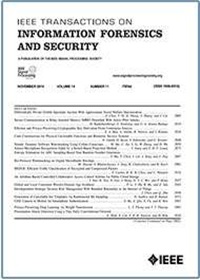Coupled-Space Attacks Against Random-Walk-Based Anomaly Detection
IF 6.3
1区 计算机科学
Q1 COMPUTER SCIENCE, THEORY & METHODS
IEEE Transactions on Information Forensics and Security
Pub Date : 2024-09-25
DOI:10.1109/TIFS.2024.3468156
引用次数: 0
Abstract
Random Walks-based Anomaly Detection (RWAD) is commonly used to identify anomalous patterns in various applications. An intriguing characteristic of RWAD is that the input graph can either be pre-existing graphs or feature-derived graphs constructed from raw features. Consequently, there are two potential attack surfaces against RWAD: graph-space attacks and feature-space attacks. In this paper, we explore this vulnerability by designing practical coupled-space (interdependent feature-space and graph-space) attacks, investigating the interplay between graph-space and feature-space attacks. To this end, we conduct a thorough complexity analysis, proving that attacking RWAD is NP-hard. Then, we proceed to formulate the graph-space attack as a bi-level optimization problem and propose two strategies to solve it: alternative iteration (alterI-attack) or utilizing the closed-form solution of the random walk model (cf-attack). Finally, we utilize the results from the graph-space attacks as guidance to design more powerful feature-space attacks (i.e., graph-guided attacks). Comprehensive experiments demonstrate that our proposed attacks are effective in enabling the target nodes to evade the detection from RWAD with a limited attack budget. In addition, we conduct transfer attack experiments in a black-box setting, which show that our feature attack significantly decreases the anomaly scores of target nodes. Our study opens the door to studying the coupled-space attack against graph anomaly detection in which the graph space relies on the feature space.针对基于随机漫步的异常检测的耦合空间攻击
基于随机漫步的异常检测(RWAD)通常用于识别各种应用中的异常模式。RWAD 的一个有趣特点是,输入图既可以是预先存在的图,也可以是由原始特征构建的特征衍生图。因此,针对 RWAD 有两个潜在的攻击面:图空间攻击和特征空间攻击。在本文中,我们通过设计实用的耦合空间(相互依存的特征空间和图空间)攻击来探索这一漏洞,研究图空间攻击和特征空间攻击之间的相互作用。为此,我们进行了全面的复杂性分析,证明攻击 RWAD 是 NP-hard。然后,我们将图空间攻击表述为一个双层优化问题,并提出了两种解决策略:替代迭代(alterI-attack)或利用随机漫步模型的闭式解(cf-attack)。最后,我们利用图空间攻击的结果作为指导,设计出更强大的特征空间攻击(即图指导攻击)。综合实验证明,我们提出的攻击能有效地使目标节点在有限的攻击预算内躲避 RWAD 的检测。此外,我们还在黑盒环境中进行了转移攻击实验,结果表明我们的特征攻击显著降低了目标节点的异常得分。我们的研究为研究针对图异常检测的耦合空间攻击打开了大门,其中图空间依赖于特征空间。
本文章由计算机程序翻译,如有差异,请以英文原文为准。
求助全文
约1分钟内获得全文
求助全文
来源期刊

IEEE Transactions on Information Forensics and Security
工程技术-工程:电子与电气
CiteScore
14.40
自引率
7.40%
发文量
234
审稿时长
6.5 months
期刊介绍:
The IEEE Transactions on Information Forensics and Security covers the sciences, technologies, and applications relating to information forensics, information security, biometrics, surveillance and systems applications that incorporate these features
 求助内容:
求助内容: 应助结果提醒方式:
应助结果提醒方式:


